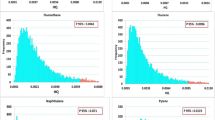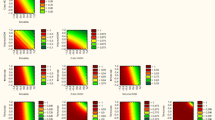Abstract
The contents of the 15+1 EU priority PAH were analysed from 113 representative commercial smoked German meat products collected in the year 2006 with a Fast-GC/HRMS method. The median of benzo[a]pyrene content was 0.03 μg/kg and therefore greater than a factor of 100 below the maximum level of 5 μg/kg. The highest content of benzo[a]pyrene was detected in a Frankfurter-type sausage (0.43 μg/kg). The sum content of benzo[a]pyrene, benzo[a]anthracene, chrysene and benzo[b]fluoranthene (“PAH4”), as proposed by the European Food Safety Authority to be a good marker for PAH in food, was 0.28 μg/kg in median, and the sum content of the 15+1 EU priority PAH was 0.64 μg/kg in median. The analysed smoked meat products showed an increasing presence of PAH in the following order: cooked ham (n = 17) < raw sausages (n = 25) < liver sausages (n = 25) < raw ham (n = 23) < Frankfurter-type sausages (n = 23). The correlation coefficient (R) between BaP and the sum of the 15+1 EU priority PAH was 0.90. To increase the safety of the consumer, a lowering of the BaP maximum level to 1 μg/kg is proposed and critical aspects using “PAH4” as a marker for PAH in food surveillance are discussed.



Similar content being viewed by others
Abbreviations
- 5MC:
-
5-Methylchrysene
- ALARA:
-
As low as reasonably achievable
- ASE:
-
Accelerated solvent extraction
- ASPEC:
-
Automatic sample preparation with extraction columns
- BaA:
-
Benzo[a]anthracene
- BaP:
-
Benzo[a]pyrene
- BbF:
-
Benzo[b]fluoranthene
- BcL:
-
Benzo[c]fluorene
- BgP:
-
Benzo[g,h,i]perylene
- BjF:
-
Benzo[j]fluoranthene
- BkF:
-
Benzo[k]fluoranthene
- CPP:
-
Cyclopenta[c,d]pyrene
- CHR:
-
Chrysene
- CRL:
-
Community reference laboratory
- DeP:
-
Dibenzo[a,e]pyrene
- DhA:
-
Dibenzo[a,h]anthracene
- DhP:
-
Dibenzo[a,h]pyrene
- DiP:
-
Dibenzo[a,i]pyrene
- DlP:
-
Dibenzo[a,l]pyrene
- EFSA:
-
European Food Safety Authority
- GC:
-
Gas chromatography
- GPC:
-
Gel permeation chromatography
- HRMS:
-
High resolution mass spectrometer
- IARC:
-
International Agency for Research on Cancer
- IcP:
-
Indeno[1,2,3-cd]pyrene
- IQR:
-
Interquartile range
- JECFA:
-
Joint FAO/WHO Experts Committee on Food Additives
- LOD:
-
Limit of detection
- LOQ:
-
Limit of quantification
- P 95:
-
95-Percentile
- PAH:
-
Polycyclic aromatic hydrocarbons
- “PAH4”:
-
Sum content of BaP, CHR, BaA, BbF
- SCF:
-
Scientific Committee on Food
- SPE:
-
Solid phase extraction
- TP:
-
Triphenylene
References
Toth L (1983) Chemie der Räucherung. Verlag Chemie, Berlin
Frede W (Hrsg.) (2006) Taschenbuch für Lebensmittelchemiker, 2. Auflage. Springer, Berlin, p 505
Sanders LC, Wise SA (1997) Polycyclic aromatic hydrocarbon index. NIST special publication 922, National Institute of Standards and Technology, Gaithersburg. http://ois.nist.gov/pahpages/index.pdf
Mottier P, Parisod V, Turesky RJ (2000) J Agric Food Chem 48:1160–1166
Commission regulation (EC) No 1881/2006 of 19 December 2006 setting maximum levels for certain contaminants in foodstuffs. Off J Eur Union L 364:5–24
Commission recommendation of 4 February 2005 on the further investigation into the levels of polycyclic aromatic hydrocarbons in certain foods. Off J Eur Union L 34:43–45
Summary and conclusion of the Joint FAO/WHO Expert Committee on Food Additives, 64th meeting, Rome, 8–17 February 2005, JECFA/64/SC
IARC, International Agency for Research on Cancer (2009) http://monographs.iarc.fr/ENG/Classification/crthgr01.php
IARC, International Agency for Research on Cancer (2009) http://monographs.iarc.fr/ENG/Classification/crthgr02a.php
IARC, International Agency for Research on Cancer (2009) http://monographs.iarc.fr/ENG/Classification/crthgr02b.php
IARC, International Agency for Research on Cancer (2009) http://monographs.iarc.fr/ENG/Classification/crthgr03.php
Falcon MSG, Amigo SG, Yusty MAL et al (1999) Food Addit Contam 16:9–14
Roda A, Simoni P, Ferri EN et al (1999) J Sci Food Agric 79:58–62
Falco G, Domingo JL, Llobet JM et al (2003) J Food Protect 66:2325–2331
Jira W (2005) Fleischwirtschaft 85(9):112–116
Fontcuberta M, Arques JF, Martinez M et al (2006) J Food Protect 69:2024–2028
Duedahl-Olesen L, White S, Binderup ML (2006) Polycycl Aromat Comp 26:163–184
FSAI, Food Safety Authority of Ireland (2006) Investigation into levels of polycyclic aromatic hydrocarbons (PAH) in food on the Irish market. http://www.fsai.ie/uploadedFiles/Monitoring_and_Enforcement/Monitoring/Surveillance/PAH_levels.pdf
Reinik M, Tamme T, Roasto M et al (2007) Food Addit Contam 24:429–437
Purcaro G, Moret S, Conte L (2009) Meat Sci 81:275–280
Jira W, Ziegenhals K, Speer K (2008) Food Addit Contam 25:704–713
European Commission (2005) Commission directive 2005/10/EC of 4 February 2005 laying down the sampling methods and the methods of analysis for the official control of the levels of benzo(a)pyrene in foodstuffs. Off J Eur Union L 34:15–20
Kleinhenz S, Jira W, Schwind KH (2006) Mol Nutr Food Res 50:362–367
Ziegenhals K, Hübschmann HJ, Speer K, Jira W (2008) J Sep Sci 31:1779–1786
Commission regulation (EC) No 333/2007 of 28 March 2007 laying down the methods of sampling and analysis for the official control of the levels of lead, cadmium, mercury, inorganic tin, 3-MCPD and benzo(a)pyrene in foodstuffs. Off J Eur Union L 88:29–39
Jira W, Schwind KH (2009) Fleischwirtschaft 89(6):94–98
European Commission (2009) Report on the third inter-laboratory comparison organised by the community reference laboratory for polycyclic aromatic hydrocarbons, ISBN: 978-92-79-11732-9, Joint Research Centre
Thompson M (2000) Analyst 125:385–386
EFSA (2008) Scientific opinion of the panel on contaminants in the food chain on a request from the european commission on polycyclic aromatic hydrocarbons in food. EFSA J 724:1–114
SCF, Scientific Committee on Food (2002) opinion of the scientific committee on food on the risks to human health of polycyclic aromatic hydrocarbons in food. http://ec.europa.eu/food/food/chemicalsafety/contaminants/out153_en.pdf
Codex Alimentarius Commission: proposed draft code of practice for the reduction of contamination of food with polycyclic aromatic hydrocarbons (PAH) from smoking and direct drying processes (2008) ftp://ftp.fao.org/codex/alinorm08/al31_41e.pdf
Nisbet I, LaGoy P (1992) Regul Toxicol Pharm 16:290–300
Bostrom C, Gerde P, Hanberg A et al (2002) Environ Health Persp 110:451–488
Acknowledgments
The author thanks K. Hillgärtner (German Agricultural Society, DLG) for providing the samples of smoked meat products, and E. Klötzer for the excellent technical assistance.
Author information
Authors and Affiliations
Corresponding author
Rights and permissions
About this article
Cite this article
Jira, W. Polycyclic aromatic hydrocarbons in German smoked meat products. Eur Food Res Technol 230, 447–455 (2010). https://doi.org/10.1007/s00217-009-1187-9
Received:
Revised:
Accepted:
Published:
Issue Date:
DOI: https://doi.org/10.1007/s00217-009-1187-9




